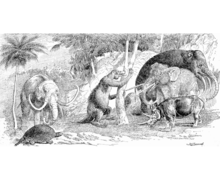Prehistoric mammal

Prehistoric mammals are groups of mammals that became extinct before humans developed writing. 164 million years ago, in the Jurassic period, Castorocauda lutrasimilis, a mammaliaform (mammal-shaped) animal weighing about 500 grams (1.1 lb), had a full mammalian pelt, with guard hairs and underfur, webbed feet, and scales on the tail like a modern beaver, as well as teeth specialized for catching fish.
Later, about 130 million years ago in the Cretaceous, there existed larger mammals; a fossil of Repenomamus giganticus indicates that the animal was about 1 meter (3 1⁄4 ft) long. In the stomach of a smaller cousin, Repenomamus robustus at 52 cm (20 1⁄2 in), the remains of a juvenile dinosaur have been preserved.
The lineages of many varieties continued through the Cenozoic era where some reached very large sizes. Most of the very large mammals became extinct in the last ice age, but have smaller descendants.
List of prehistoric mammals
Prehistoric mammals include:
See also
- Cynodont
- List of extinct mammals
- Mammaliaformes
- Megamammals
- Pleistocene extinctions
- Pleistocene megafauna
- Synapsid
- Therapsid